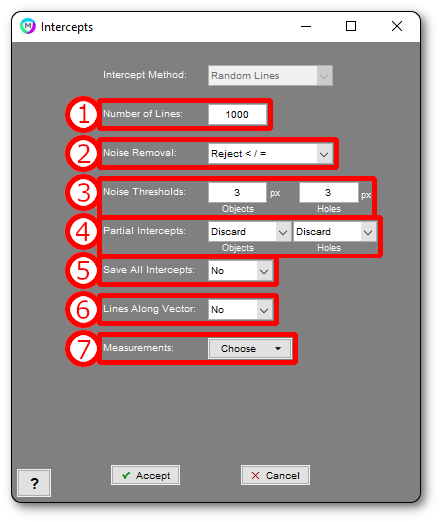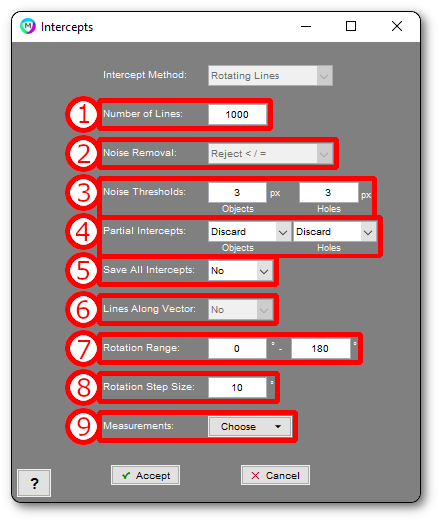Measurements > Intercepts
Random Lines
Measures metrics such as mean intercept by drawing a specified number of random or rotating lines through the features in the Current Image.

1. Number of Lines
Number of lines to draw
2. Noise Removal
Method for removing small intercepts
- Reject < / =: Simply ignores intercepts below a certain length
- Fit to Noise: (Only for “Random Lines”) Fits an exponential to the first few bins and subtracts this exponential out of the intercept histogram.
3. Noise Thresholds
Thresholds for either the minimum intercept length (for “Reject </=”), the number of bins to use for “Fit to Noise”
4. Partial Intercepts
Choose whether to discard or keep intercepts that start or end at an image edge
5. Save All Intercepts
Choose whether to save all intercept lengths into text files
6. Lines Along Vector
Choose whether to draw all “Random Lines” along a specific direction. Starting points of each line will still be random.
7. Measurements
Choose which measurements to report (described below).
Rotating Lines
Measures metrics such as mean intercept by rotating a grid of specified number of lines through the features in the Current Image.

1. Number of Lines
Number of lines to draw
2. Noise Removal
Method for removing small intercepts
- Reject < / =: Simply ignores intercepts below a certain length
- Fit to Noise: (Only for “Random Lines”) Fits an exponential to the first few bins and subtracts this exponential out the intercept histogram.
3. Noise Thresholds
Thresholds for either the minimum intercept length (for “Reject </=”), the number of bins to use for “Fit to Noise”
4. Partial Intercepts
Choose whether to discard or keep intercepts that start or end at an image edge
5. Save All Intercepts
Choose whether to save all intercept lengths into text files
6. Lines Along Vector
Disabled in “Rotating Lines” mode
7. Rotation Range
Range of angles through which to rotate the grid of parallel lines
8. Rotation Step Size
Increment with which to step though angle range to rotate the grid of parallel lines
9. Measurements
Choose which measurements to report (described below).
Measurements
- Mean Intercept – Objects: Average length of intercepts which pass through selected features (objects)
- Mean Intercept – Holes: Average length of intercepts which pass through un-selected areas (holes)
- Mean Inverse Intercept – Objects: Average inverse length of intercepts which pass through selected features (objects)
- Mean Inverse Intercept – Holes: Average inverse length of intercepts which pass through un-selected areas (holes)
- Mode Intercept – Objects: Mode (most common) length of intercepts which pass through selected features (objects)
- Mode Intercept – Holes: Mode (most common) length of intercepts which pass through un-selected areas (holes)
- Mode Inverse Intercept – Objects: Mode (most common) inverse length of intercepts which pass through selected features (objects)
- Mode Inverse Intercept – Holes: Mode (most common) inverse length of intercepts which pass through un-selected areas (holes)
- ASTM Grain Size Number: ASTM standard grain size number derived from mean intercept length through selected features (objects)
- Total Line Length: Total length of all lines which are drawn in order to collect intercepts.
- Total Intersections: Number of intersections produced between the drawn lines and intercepted features.
References
[1] ASTM E112-13, Standard Test Methods for Determining Average Grain Size, ASTM International, West Conshohocken, PA, 2013, www.astm.org
Need more help with this?
Chat with an expert now ››


